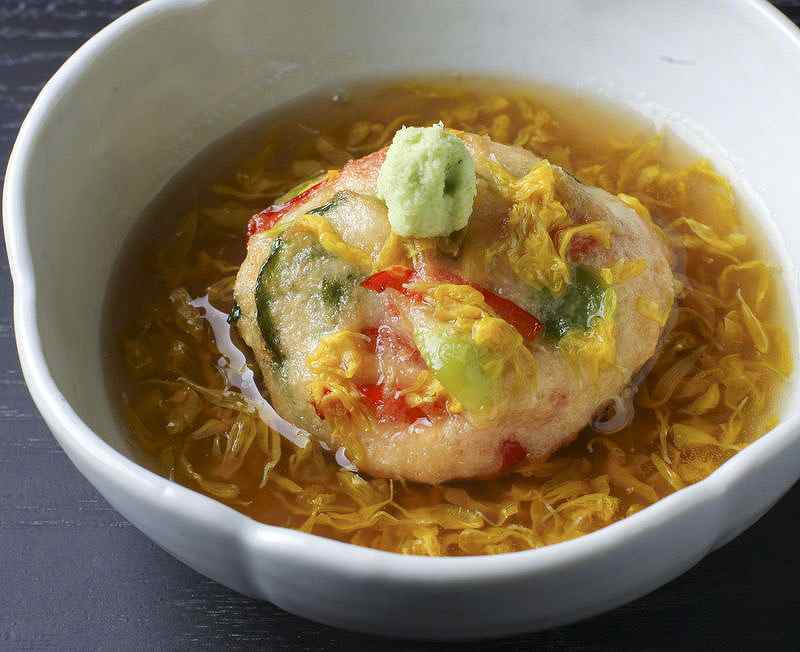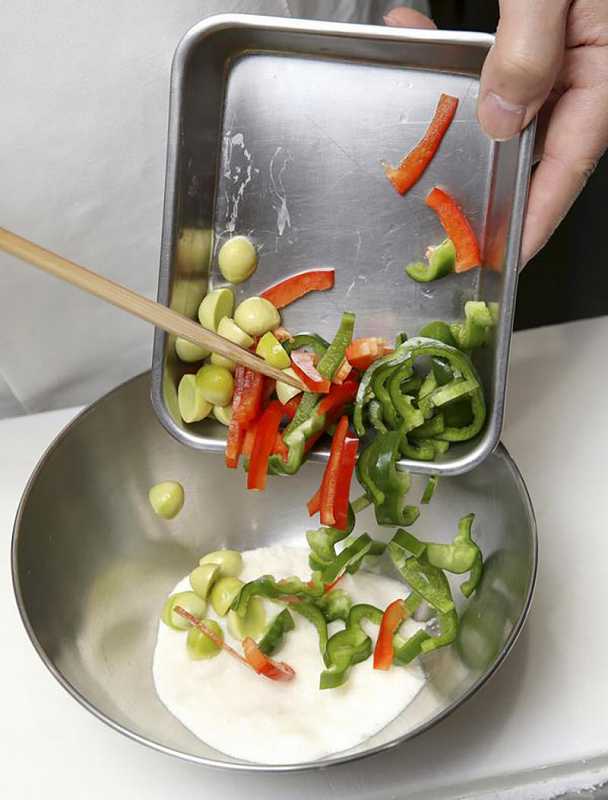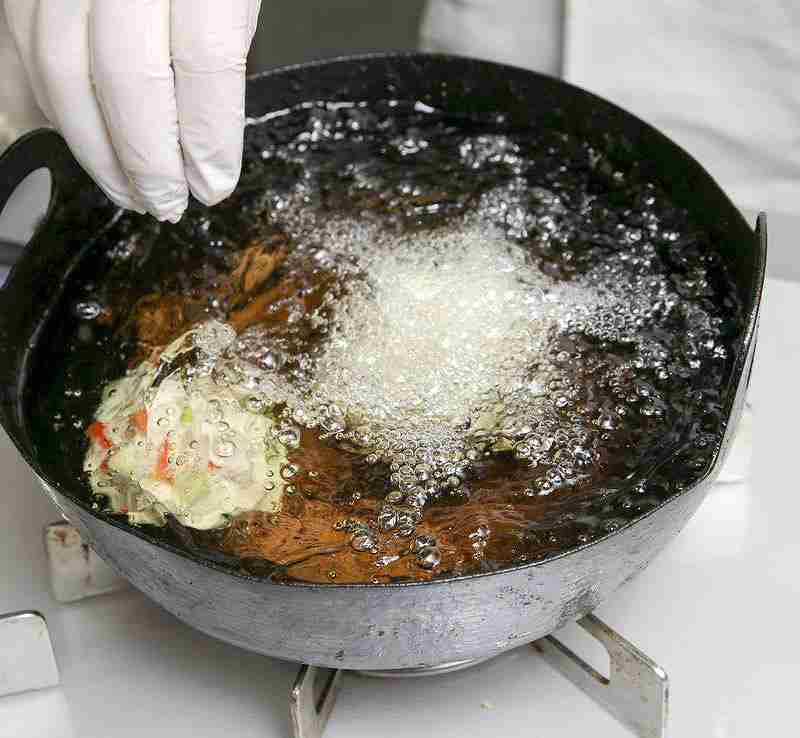
Joyo manju
November 9, 2021
Joyo manju, a yam-based bun with vegetables, is a beautiful dish with a delicate taste. Japanese cooking specialist Takamitsu Aihara shared a quick and easy recipe of the dish that is modeled after a bush clover, which is in bloom around this time of the year.
The word “joyo” means yamato-imo or naga-imo, which are varieties of yam. Joyo manju can refer to both sweet buns and dishes made of yam.
In Japanese cuisine, there is a dish called “hagi shinjo,” which also uses grated yamato-imo. Bush clover, or hagi in Japanese, is one of “the seven flowers of autumn.” However, making this dish requires time and effort.
Instead, Aihara suggests a simpler recipe to make his joyo manju by mixing all the ingredients together, shaping it into portions and deep-frying them.
Red bell peppers represent the bush clover’s flowers and yellow ginkgo nuts the leaves. Green bell peppers are also used to hearken back the vivid green leaves of summer. Petals of yellow edible chrysanthemum flowers are added to a thick sauce also as a seasonal feature.

Grated yamato-imo, green and red bell pepper strips and gingko nuts are mixed in a bowl.
“It’s quite good, especially when it’s just been deep-fried,” Aihara said. “I think you’ll enjoy it all the more as temperatures head into winter.”
Although the recipe is simple, there are some points to remember.
First, lightly wet your hands with water when shaping each portion before placing them in the hot oil.
“You can also use a small bowl and a cooking paddle or similar utensil to shape the mixture into portions. Make sure to wet the inside of the bowl,” Aihara said.
Before making the thick sauce, quickly boil the petals of the edible chrysanthemum, adding a small amount of vinegar to the water. Drain the petals in a strainer, instead of cooling them in cold water, to prevent the vivid color from fading.
The joyo manju is topped with the thick sauce and a small chunk of grated wasabi as a condiment. The vivid yellow of the chrysanthemum petals is particularly refreshing and brightens up the dish. Yamato-imo has a good texture and mild flavor, while the green bell peppers and the ginkgo nuts accentuate the dish.
Joyo manju
Ingredients (serves 2):
100 grams yamato-imo yam (peeled)
30 grams green bell pepper
20 grams red bell pepper
10 ginkgo nuts in shells
3 edible chrysanthemum flowers
Some wasabi
250 ml dashi stock
20 ml water with kuzu starch
Vinegar
1⅓ tbsp light soy sauce
2 tsp mirin
1 tsp sake
Salt
Directions:
1. Peel yam and grate.
2. Remove seeds from red and green bell peppers and slice them into thin strips less than 5 millimeters wide.
3. Crack ginkgo shells with kitchen scissors and take out nuts. Soak in water for about 5 minutes, peel, and cut into halves.
4. Tear off petals of edible chrysanthemum flowers, boil briefly in boiling water with a little vinegar, and drain in strainer.
5. Place yamato-imo, green and red bell peppers, and ginkgo nuts in a bowl, mix, divide into two equal portions and shape appropriately.
6. Deep-fry the portions slowly in oil at 160 C until the surface becomes golden brown. Be careful not to burn.
7. To make the chrysanthemum sauce, place dashi stock, light soy sauce, mirin and sake in a pan and heat. When it comes to a boil, add a pinch of salt and water containing kuzu starch, and stir immediately. When it comes to a boil again, add chrysanthemum petals and remove from the heat.
8. Place the fried joyo manju in a bowl, pour on the thick sauce and top with grated wasabi.

Portions are deep-fried.
Side dish with tosa vinegar
If there is any leftover yam, Aihara recommends grating it and adding tosa vinegar to make a side dish. The dish can be good especially when you have little appetite.
Tosa vinegar is a mixture of 3 parts dashi stock, 1 part light soy sauce, 1 part vinegar, and 0.6 part mirin. Add to grated yam and lightly mix. The amount of tosa vinegar depends on your preference, but basically 1 to 1½ parts tosa vinegar for 1 part yamato-imo.
Serve the mixture in a bowl and squeeze sudachi Japanese citrus, or add grated sudachi peel as a condiment.
"Features" POPULAR ARTICLE
-

Sanrio to Open Museum in Yamanashi Pref. Dedicated to Founder, Exhibits Include Hello Kitty, Other Characters
-

Autumn Foliage Surrounds Visitors to Tokyo’s Showa Kinen Park
-

My Daughter No Longer Speaks to Me, But I Want to See Her and My Grandchild
-

Kumamoto: Public Bath Refurbished as Library Where You Can Chat, Take Photos
-

Frozen Vegetables: Demand Rises for Convenient, Tasty Domestic Produce
JN ACCESS RANKING
-

Tokyo Economic Security Forum to Hold Inaugural Meeting Amid Tense Global Environment
-

Keidanren Chairman Yoshinobu Tsutsui Visits Kashiwazaki-Kariwa Nuclear Power Plant; Inspects New Emergency Safety System
-

Imports of Rare Earths from China Facing Delays, May Be Caused by Deterioration of Japan-China Relations
-

University of Tokyo Professor Discusses Japanese Economic Security in Interview Ahead of Forum
-

Japan Pulls out of Vietnam Nuclear Project, Complicating Hanoi’s Power Plans


























